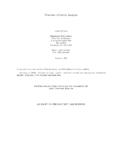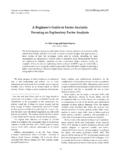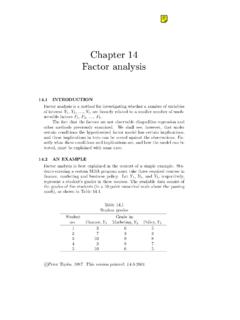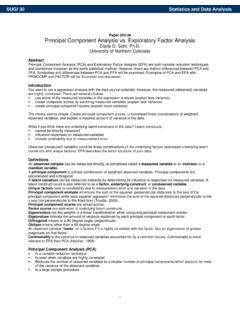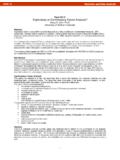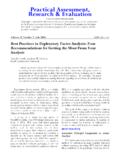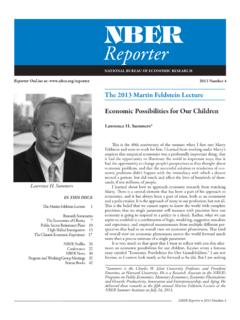Transcription of 15. Analysis of Variance - onlinestatbook.com
1 15. Analysis of ANOVA (Between-Subjects) ANOVA (Between-Subjects) Sample Supplementing ANOVA517 Introductionby David M. LanePrerequisites Chapter 3: Variance Chapter 11: Significance Testing Chapter 12: All Pairwise Comparisons among Means Learning null hypothesis is tested by the uses of ANOVAA nalysis of Variance (ANOVA) is a statistical method used to test differences between two or more means. It may seem odd that the technique is called Analysis of Variance rather than Analysis of Means. As you will see, the name is appropriate because inferences about means are made by analyzing Variance . ANOVA is used to test general rather than specific differences among means.
2 This can be seen best by example. In the case study Smiles and Leniency, the effect of different types of smiles on the leniency shown to a person was investigated. Four different types of smiles (neutral, false, felt, miserable) were investigated. The chapter All Pairwise Comparisons among Means showed how to test differences among means. The results from the Tukey HSD test are shown in Table 1. Six pairwise - - - - - - that the only significant difference is between the False and Neutral tests the non-specific null hypothesis that all four population means are equal. That is false = felt = miserable = non-specific null hypothesis is sometimes called the omnibus null hypothesis.
3 When the omnibus null hypothesis is rejected, the conclusion is that at least one population mean is different from at least one other mean. However, since the ANOVA does not reveal which means are different from which, it offers less specific information than the Tukey HSD test. The Tukey HSD is therefore preferable to ANOVA in this situation. Some textbooks introduce the Tukey test only as a follow-up to an ANOVA. However, there is no logical or statistical reason why you should not use the Tukey test even if you do not compute an might be wondering why you should learn about ANOVA when the Tukey test is better. One reason is that there are complex types of analyses that can be done with ANOVA and not with the Tukey test.
4 A second is that ANOVA is by far the most commonly-used technique for comparing means, and it is important to understand ANOVA in order to understand research of Variance Designsby David M. LanePrerequisites Chapter 15: Introduction to ANOVAL earning able to identify the factors and levels of each factor from a description of an whether a factor is a between-subjects or a within-subjects factorial designThere are many types of experimental designs that can be analyzed by ANOVA. This section discusses many of these designs and defines several key terms and LevelsThe section on variables defined an independent variable as a variable manipulated by the experimenter.
5 In the case study Smiles and Leniency, the effect of different types of smiles on the leniency showed to a person was investigated. Four different types of smiles (neutral, false, felt, miserable, on leniency) were shown. In this experiment, Type of Smile is the independent variable. In describing an ANOVA design, the term factor is a synonym of independent variable. Therefore, Type of Smile is the factor in this experiment. Since four types of smiles were compared, the factor Type of Smile has four ANOVA conducted on a design in which there is only one factor is called a one-way ANOVA. If an experiment has two factors , then the ANOVA is called a two-way ANOVA.
6 For example, suppose an experiment on the effects of age and gender on reading speed were conducted using three age groups (8 years, 10 years, and 12 years) and the two genders (male and female). The factors would be age and gender. Age would have three levels and gender would have two and Within-Subjects FactorsIn the Smiles and Leniency study, the four levels of the factor Type of Smile were represented by four separate groups of subjects. When different subjects are used for the levels of a factor, the factor is called a between-subjects factor or a between-subjects variable. The term between subjects reflects the fact that comparisons are between different groups of the ADHD Treatment study, every subject was tested with each of four dosage levels (0, , , mg/kg) of a drug.
7 Therefore there was only one group of subjects, and comparisons were not between different groups of subjects but between conditions within the same subjects. When the same subjects are used for the levels of a factor, the factor is called a within-subjects factor or a within-subjects variable. Within-subjects variables are sometimes referred to as repeated-measures variables since there are repeated measurements of the same DesignsIt is common for designs to have more than one factor. For example, consider a hypothetical study of the effects of age and gender on reading speed in which males and females from the age levels of 8 years, 10 years, and 12 years are tested.
8 There would be a total of six different groups as shown in Table 1. Gender x Age DesignGroupGenderAge1 Female82 Female103 Female124 Male85 Male106 Male12 This design has two factors : age and gender. Age has three levels and gender has two levels. When all combinations of the levels are included (as they are here), the design is called a factorial design. A concise way of describing this design is as a Gender (2) x Age (3) factorial design where the numbers in parentheses indicate 521the number of levels. Complex designs frequently have more than two factors and may have combinations of between- and within-subjects ANOVA (Between Subjects)by David M.
9 LanePrerequisites Chapter 3: Variance Chapter 7: Introduction to Normal Distributions Chapter 11: Significance Testing Chapter 11: One- and Two-Tailed Tests Chapter 12: t Test of Differences Between Groups Chapter 15: Introduction to ANOVA Chapter 15: ANOVA Designs Learning what the Mean Square Error (MSE) estimates when the null hypothesis is true and when the null hypothesis is what the Mean Square Between (MSB) estimates when the null hypothesis is true and when the null hypothesis is the assumptions of a one-way F and its two degrees of freedom the shape of the F why ANOVA is best thought of as a two-tailed test even though literally only one tail of the distribution is the relationship between the t and F the sums of squares into conditions and data to be used with a computer statistics programThis section shows how ANOVA can be used to analyze a one-factor between-subjects design.
10 We will use as our main example the Smiles and Leniency case study. In this study there were four conditions with 34 subjects in each condition. There was one score per subject. The null hypothesis tested by ANOVA is that the population means for all conditions are the same. This can be expressed as follows:H0: 1 = 2 = .. = k523where H0 is the null hypothesis and k is the number of conditions. In the smiles and leniency study, k = 4 and the null hypothesis isH0: false = felt = miserable = the null hypothesis is rejected, then it can be concluded that at least one of the population means is different from at least one other population of Variance is a method for testing differences among means by analyzing Variance .




